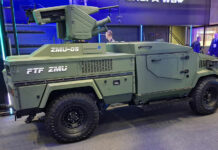Following its plan to expand the former Killer-Bee platform it acquired from Swift Engineering in 2009 into a family of UAVs, last month Northrop Grumman flew the first in a new series of BAT unmanned aircraft systems (UAS). The unmanned vehicle that flew in January 2010 was the BAT-12, a new, 12-foot wingspan (3.65 m’) version powered by a German engine made by Göbler-Hirthmotoren, originally designed for ultra-light aircraft. The BAT-12 uses a five-blade propeller, contributing to low acoustic signature of the platform. The system was also tested with a new mission payload, comprising stabilized Short Wave Infrared (SWIR) and miniature Synthetic Aperture radar (NanoSAR).

Recently, the BAT has been integrated and tested with new payload comprising the T2 Delta dual payload micro-gimbal from Goodrich Corporation’s Cloud Cap Technology Inc, mounting the short wave infrared (SWIR) camera from Goodrich and the Sentient Vision Systems’ Kestral real-time moving target indicator. In February 2010 payload integration and testing was expanded to include ImSAR’s Nano-SAR-B fused with Cloud Cap’s T2 gimbal in a cursor-on-target acquisition mode.
During recent testing, the 12-foot and 10-foot (3.04 m’) wingspan Bats were successfully launched from a transportable launcher used for the AAI Shadow. The BATs were autonomously operated from a single ground control station before recovery via net. As a communications relay using Northrop Grumman’s Software Defined Tactical Radio, BAT has also demonstrated its capacity to provide beyond line-of-sight tactical communications relay for ground forces in denied environments, a critical role in irregular warfare.

















